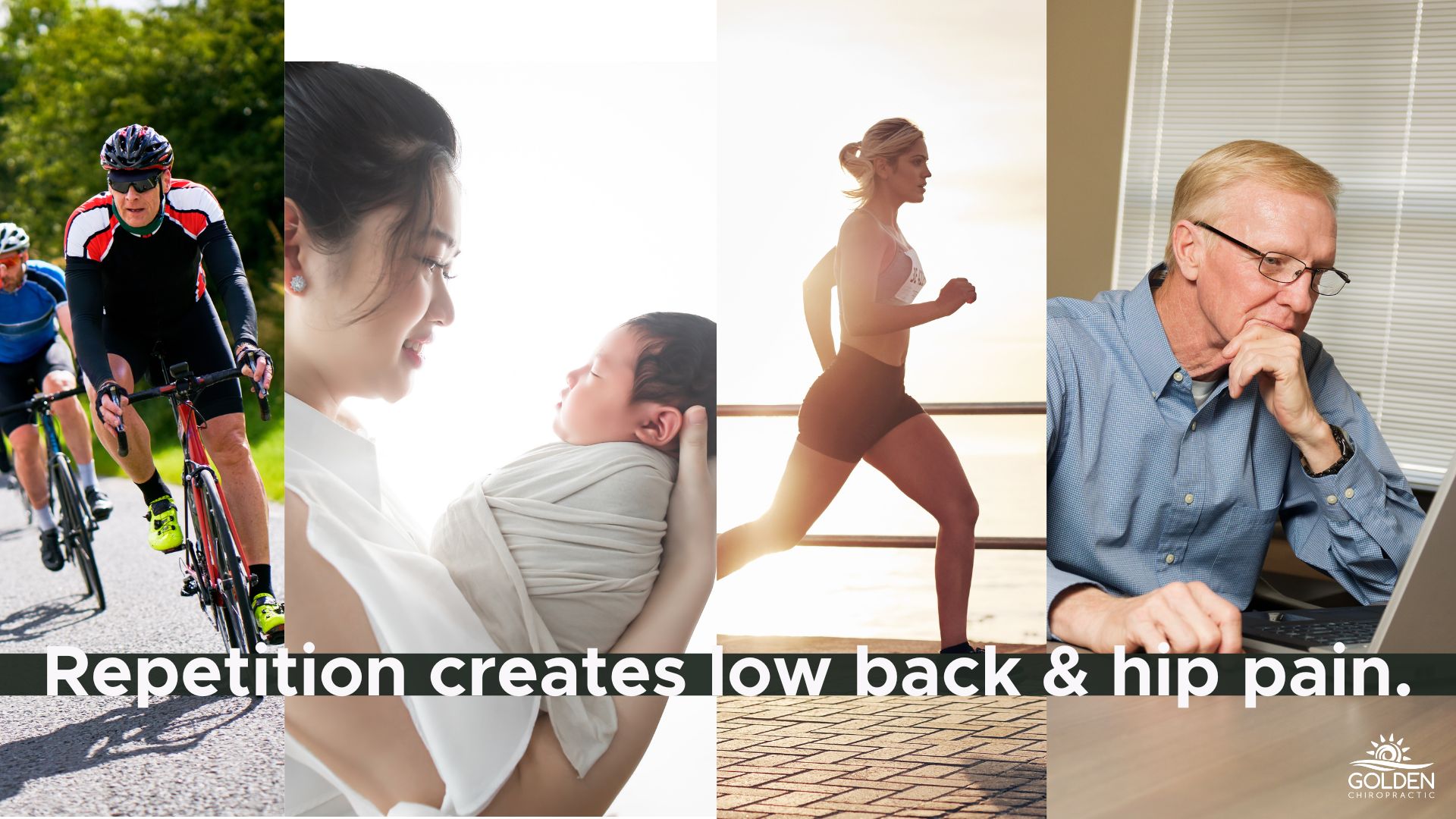
07/11/2024 by Dr. Joe Bell
Stand Up for Your Lower Back and Hips
Chronic lower back pain and hip discomfort are common symptoms of a condition known as Lower Cross Syndrome (LCS). This postural condition often affects people who sit for prolonged periods of time.
If you’re commuting long distances for work, and/or working in an office with a poor ergonomic setup, Lower Cross Syndrome could be the cause of your lower back and hip pain.
We also see LCS in other groups, like new moms that frequently slouch over their baby, runners, and cyclists.
LCS comes from strengthening, tightening, and weakening muscle groups in ways that create an imbalance in your musculoskeletal system.
How does your lifestyle contribute to Lower Cross Syndrome?
LCS can be caused by any habitual or regular activity that encourages:
- Tightened hip flexors (muscles at the front of your thigh)
- Tightened lower back extensors (muscles at your lower back)
- Weakened abdominal(stomach) muscles
- Weakened gluteal (butt) muscles
LCS stems from a postural imbalance. Tight hip flexors and lower back extensors, paired with weak abdominal and gluteal muscles create a "cross" pattern of dysfunction, leading to pain and discomfort.
Common lifestyle factors contributing to LCS include:
- Sitting for long periods with poor posture
- Incorrect ergonomic setups at work or home
- Prolonged commuting
- Constantly slouching over a baby for feeding, holding, and carrying
- Overtraining the hip flexors in sports like running
- Spending a lot of time in hip flexion in sports like cycling
Holding a prolonged posture doing any of the above can lead to postural imbalances like:
- Increased lumbar lordosis (exaggerated lower back arch)
- Anterior pelvic tilt (forward tilting of the pelvis)
- Weakened abdominals
- Weakened gluteal muscles
What are the symptoms of Lower Cross Syndrome?
Our patients will commonly experience pain in their lower back, as well as in the front of their body at the hips.
Patients may also feel instability in their pelvis, or like their posture is unbalanced.
Common symptoms of LCS include:
- Lower back pain
- Hip pain and tightness
- Difficulty standing or walking for long periods
- Restricted range of motion in the hips and lower back
- Feelings of instability in the pelvis
- Exaggerated lower back arch (lumbar lordosis)
- Forward tilting pelvis
These symptoms tend to interfere with daily activities. Chronic pain can be incredibly stressful, and managing appointments with various healthcare providers often adds to the emotional burden.
Living with the chronic pain of LCS can lead to frustration, anxiety, depression, fear, and anger. That's why it’s good to seek treatment.
How do chiropractors diagnose Lower Cross Syndrome?
Diagnosing LCS typically involves taking a detailed patient history and conducting a postural assessment. Key diagnostic tools include:
- Noting a history of prolonged sitting or poor ergonomic practices
- Observation of visible anterior pelvic tilt and increased lumbar lordosis
- Muscle strength tests revealing weak gluteal and abdominal muscles
- Palpation of the lumbar extensors and hip flexors to reveal tightness
In most cases, extensive imaging is unnecessary, though we may recommend X-rays or other tests to rule out other conditions.
How does chiropractic help with Lower Cross Syndrome?
Chiropractic care addresses muscle imbalances and areas of weakness.
Techniques such as myofascial release, blading, and manual adjustments can help alleviate symptoms.
Early intervention and consistent treatments prevent the progression of LCS, and education on ergonomic work setups further supports recovery.
How do chiropractors treat Lower Cross Syndrome?
Treatment often involves:
- Mobilization and stretching to relieve tightness in your hip flexors and lower back
- Strengthening exercises focused on the abdominal and gluteal muscles, often using resistance bands and free weights
- Myofascial release and manual adjustments to address muscle imbalances and improve range of motion
- Ergonomic modification guidance to set up your workspace to reduce strain
How long does it take for chiropractic to work on Lower Cross Syndrome?
For most patients, we typically see significant improvement in 4-6 visits.
Your continued success relies on making the recommended ergonomic modifications and performing your home exercises consistently.
The best treatment results come from a combination of professional care and your commitment to maintaining proper habits and posture.
What is the best self-care for Lower Cross Syndrome?
Effective self-care for LCS includes:
- Practicing postural awareness: Maintain a neutral spine
- Avoiding prolonged sitting or standing: Switch between sitting and standing throughout the day
- Using a proper work chair with lumbar support
- Wearing proper footwear: Shoes with the right insoles support your lower extremity
- Getting regular exercise: Especially targeting your abdominal and gluteal muscles to prevent imbalances
- Practicing a healthy lifestyle: Get adequate sleep, focus on proper nutrition, and maintain a healthy weight
Are you experiencing lower back and hip pain?
If you're experiencing the symptoms of LCS, we encourage you to visit our office in Aptos. Schedule an online appointment today.
With the right personalized treatment plan, our chiropractors will help reduce your pain and improve your quality of life.
Want to learn more about the conditions that affect your lower back and hips?
Read Hip Pain and Chiropractic Care and Chiropractic for Common Low Back Conditions
